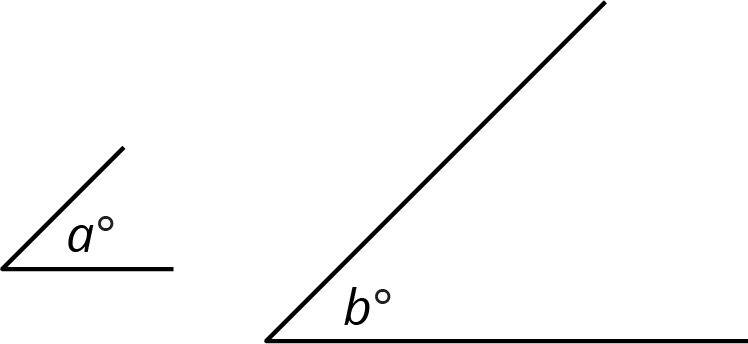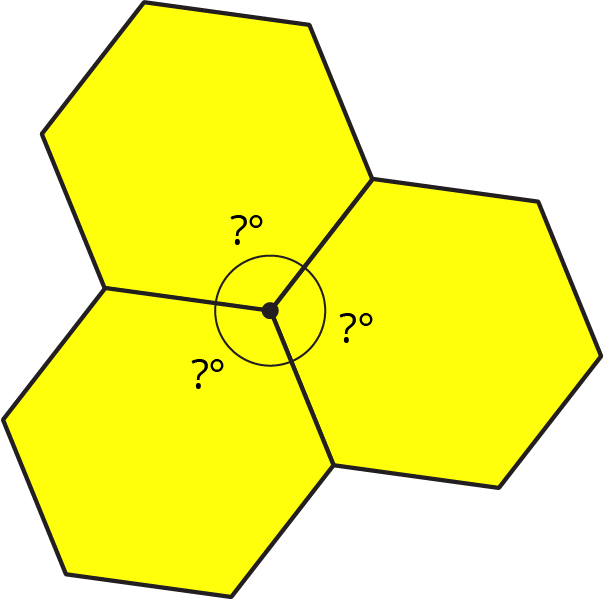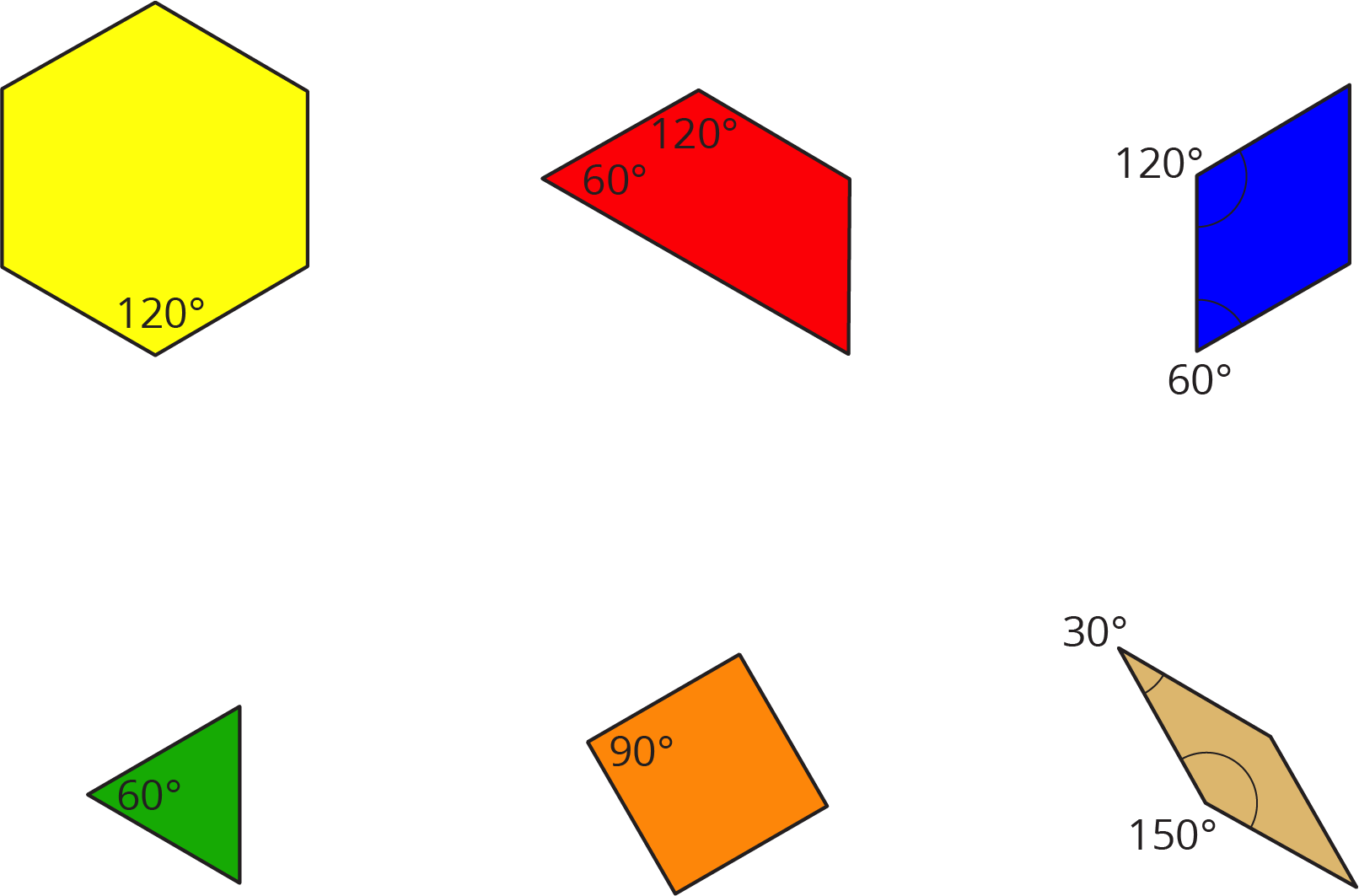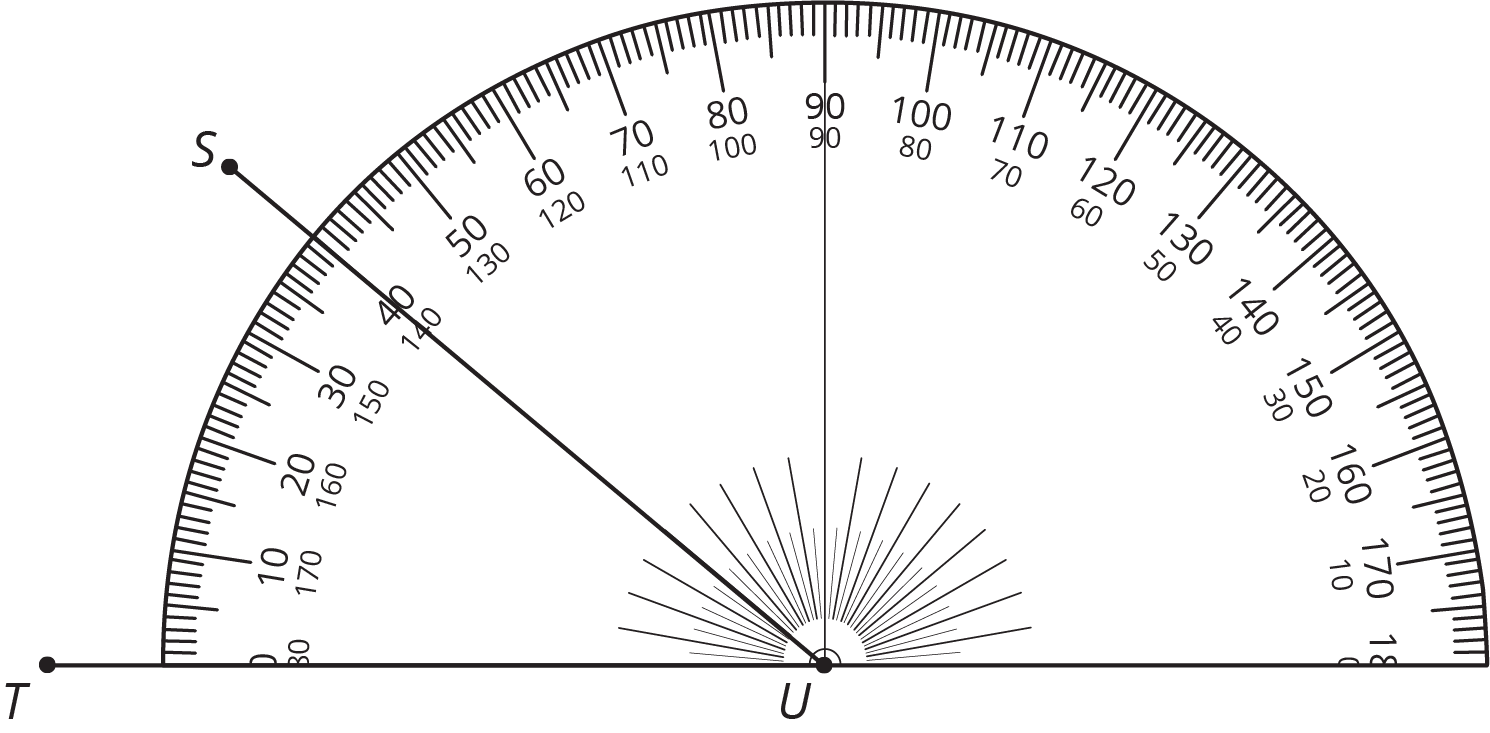Lesson 1
Relationships of Angles
1.1: Visualizing Angles (5 minutes)
Warm-up
The purpose of this warm-up is to bring back to mind what students have learned previously about angle measures, as well as to discuss what aspects of each figure is important and which aspects can be ignored. Students may benefit from the use of an Angle Window: a scrap of paper with a penny-sized hole torn in the center of it. Students position the window so that the vertex of the angle and the beginning of the two rays are visible through the hole. This helps block out distractions, such as the lengths on the sides of the angle or other objects in the diagram.
The first question addresses the misconception that the size of an angle is related to lengths of line segments. The second question shows students they must be specific about how they refer to angles that share a vertex and introduces students to thinking about overlapping angles. Monitor for students who use different names for the same angle.
Launch
Give students 1 minute of quiet work time, followed by a whole-class discussion.
If using the digital activity, make sure students realize they can drag the angles to compare size.
Student Facing
Use the applet to answer the questions.
- Which angle is bigger, \(a\) or \(b\)?
- Identify an obtuse angle in the diagram.
Student Response
For access, consult one of our IM Certified Partners.
Launch
Give students 1 minute of quiet work time, followed by a whole-class discussion.
If using the digital activity, make sure students realize they can drag the angles to compare size.
Student Facing
-
Which angle is bigger?

-
Identify an obtuse angle in the diagram.

Student Response
For access, consult one of our IM Certified Partners.
Anticipated Misconceptions
In the first question, students may say that the angle measuring \(b\) degrees is larger than the angle measuring \(a\) degrees because the line segments are longer. Show them how to use an Angle Window positioned over the vertex to focus on the amount of turn between the two rays and ignore the length of the line segments.
In the second question, students may say that there is no obtuse angle, because they are only looking at \(\angle DAC\) and \(\angle CAB\) and not noticing the overlapping angle \(\angle DAB\). Reassure them that there is an obtuse angle in the figure, and ask them if \(\angle DAC\) and \(\angle CAB\) are the only angles present in the figure. Another possibility is to tell them that the obtuse angle has a measure of 110 degrees to help them find it.
Activity Synthesis
The goal of this discussion is to ensure that students understand that angles measure the amount of turn between two different directions. Poll the class on their responses for the first question. Make sure students reach an agreement that both angles in the first question are the same size. If there is a lot of disagreement, it may be helpful to demonstrate the use of an Angle Window for the whole class. If using the digital version of the materials, either angle \(a\) or \(b\) can be dragged on top of the other to demonstrate that they have the same measure.
Display the figure in the second question, and ask previously identified students to share their responses. Make sure students understand that saying angle \(A\) is not specific enough when referring to this diagram, because there is more than one angle with its vertex at point \(A\). Consider asking questions like these:
- “What is the measure of angle \(A\)?”
- “Which angle is angle \(A\)?”
- “Why is it not good enough to say angle \(A\) when referring to this diagram?”
Explain to the students that by using three points to refer to an angle, we can be sure that others will understand which angle we are talking about. Have students practice this way of referring to angles by asking questions such as:
- “Which angle is bigger, angle \(DAC\) or angle \(CAB\)?” (Angle \(DAC\) is bigger because its measure is 60 degrees. It doesn’t matter that segment \(BA\) is longer than segment \(DA\).)
- “Which angle is bigger, angle \(CAB\) or angle \(BAC\)?” (They are both the same size, because they are two names for the same angle.)
Also explain to students that in a diagram an arc is often placed between the two sides of the angle being referenced.
Tell students that angles \(DAC\) and \(CAB\) are known as adjacent angles because they are next to each other, sharing segment \(AC\) as one of their sides and \(A\) as their vertex.
1.2: Pattern Block Angles (15 minutes)
Activity
The purpose of this activity is to use the fact that the sum of the angles all the way around a point is \(360 ^\circ\) to reason about the measure of other angles. Students are reminded that angle measures are additive (4.MD.C.7) before undertaking work with complementary and supplementary angles in future lessons.
Formally, a right angle is \(90^\circ\) because we defined \(360^\circ\) to be all the way around and \(\frac14 \boldcdot 360 = 90\). Students may have forgotten about \(360^\circ\), but they are likely to remember \(90^\circ\) from their work with angles in grade 4. We can use right angles as a tool to rediscover that all the way around must be \(360^\circ\), because \(4 \boldcdot 90 = 360\).
In this activity, students use pattern blocks to explore configurations that make \(360 ^\circ\) and to solve for angles of the individual blocks. For this activity, there are multiple configurations of blocks that will accomplish the task.
As students work, monitor for those who:
- use similar reasoning in the launch to figure out the measure of the various angles they traced from the pattern blocks.
- find relationships between different angle measures and different pattern blocks (for example: one hexagon angle is also 2 green triangles, which means one green triangle angle is \(60^\circ\) because \(\frac12 \boldcdot 120 =60\).
Launch
Arrange students in groups of 3–4. Display the figures in this image one at a time, or use actual pattern blocks to recreate these figures for all to see.

Ask these questions after each figure is displayed:
- “What is the measure of \(\angle a\)? How do you know?” (\(90 ^\circ\), because it is a right angle.)
- “What is the measure of \(a + b + c\)?” (\(270 ^\circ\), because \(90 + 90 + 90 = 270\).)
- “What is the measure of \(a + b + c + d\)?” (\(360 ^\circ\), because \(4 \boldcdot 90 = 360\).)
Reinforce that \(360 ^\circ\) is once completely around a point by having students stand up, hold their arm out in front of them, and turn \(360 ^\circ\) around. Students who are familiar with activities like skateboarding or figure skating will already have a notion of \(360 ^\circ\) as a full rotation and \(180 ^\circ\) as half of a rotation.
Distribute pattern blocks. Or, if using the digital version of materials, demonstrate the use of the applet. Ensure students know that after they drag a block from the left to the right side of the window, they can click to rotate the block.
Supports accessibility for: Conceptual processing; Memory
Student Facing
- Look at the different pattern blocks inside the applet. Each block contains either 1 or 2 angles with different degree measures. Which blocks have only 1 unique angle? Which have 2?
-
If you place three copies of the hexagon together so that one vertex from each hexagon touches the same point, as shown, they fit together without any gaps or overlaps. Use this to figure out the degree measure of the angle inside the hexagon pattern block.

- Figure out the degree measure of all of the other angles inside the pattern blocks. (Hint: turn on the grid to help align the pieces.) Be prepared to explain your reasoning.
Student Response
For access, consult one of our IM Certified Partners.
Launch
Arrange students in groups of 3–4. Display the figures in this image one at a time, or use actual pattern blocks to recreate these figures for all to see.

Ask these questions after each figure is displayed:
- “What is the measure of \(\angle a\)? How do you know?” (\(90 ^\circ\), because it is a right angle.)
- “What is the measure of \(a + b + c\)?” (\(270 ^\circ\), because \(90 + 90 + 90 = 270\).)
- “What is the measure of \(a + b + c + d\)?” (\(360 ^\circ\), because \(4 \boldcdot 90 = 360\).)
Reinforce that \(360 ^\circ\) is once completely around a point by having students stand up, hold their arm out in front of them, and turn \(360 ^\circ\) around. Students who are familiar with activities like skateboarding or figure skating will already have a notion of \(360 ^\circ\) as a full rotation and \(180 ^\circ\) as half of a rotation.
Distribute pattern blocks. Or, if using the digital version of materials, demonstrate the use of the applet. Ensure students know that after they drag a block from the left to the right side of the window, they can click to rotate the block.
Supports accessibility for: Conceptual processing; Memory
Student Facing
- Trace one copy of every different pattern block. Each block contains either 1 or 2 angles with different degree measures. Which blocks have only 1 unique angle? Which have 2?
-
If you trace three copies of the hexagon so that one vertex from each hexagon touches the same point, as shown, they fit together without any gaps or overlaps. Use this to figure out the degree measure of the angle inside the hexagon pattern block.

- Figure out the degree measure of all of the other angles inside the pattern blocks that you traced in the first question. Be prepared to explain your reasoning.
Student Response
For access, consult one of our IM Certified Partners.
Student Facing
Are you ready for more?
We saw that it is possible to fit three copies of a regular hexagon snugly around a point.
Each interior angle of a regular pentagon measures \(108^\circ\). Is it possible to fit copies of a regular pentagon snugly around a point? If yes, how many copies does it take? If not, why not?

Student Response
For access, consult one of our IM Certified Partners.
Anticipated Misconceptions
When working on calculating the angle measure, students might need to be reminded that a complete turn is \(360^\circ\).
If students place angles that are not congruent next to each other, it could produce valid reasoning, but they may draw erroneous conclusions. For example, using four copies of the blue rhombus, you can place 2 obtuse angles and 2 acute angles around the same vertex with no gaps or overlaps. However, this does not mean that they are each \(\frac14\) of \(360^\circ\). Encourage students to reason about whether their conclusions make sense and to verify their conclusions in more than one way.
Activity Synthesis
The goal of this discussion is for students to be exposed to writing equations that represent the relationships between different angle measures. Select previously identified students to share how they figured out the different angle measures in each pattern block. Sequence the explanations from most common (reminiscent of the square and hexagon examples) to most creative.
Write an equation to represent how their angles add up to \(360 ^\circ\). Listen carefully for how students describe their reasoning and make your equation match the vocabulary they use. For example, students might have reasoned about 6 green triangles by thinking \(60 + 60 + 60 + 60 + 60 + 60 = 360\) or \(6 \boldcdot 60 = 360\) or \(360 \div 6 = 60\).
Once an angle from one block is known, it can be used to help figure out angles for other blocks. For example, students may say that they knew the angles on the yellow hexagon measured \(120 ^\circ\) because they could fit two of the green triangles onto one corner of the hexagon, and \(60 + 60 = 120\) or \(2 \boldcdot 60 = 120\). There are many different ways students could have reasoned about the angles on each block, and it is okay if they didn’t think back to \(360 ^\circ\) for every angle.
Before moving on to the next activity, ensure that students know the measure of each interior angle of each shape in the set of pattern blocks. Display these measures for all to see throughout the remainder of the lesson.

Design Principle(s): Support sense-making; Maximize meta-awareness
1.3: More Pattern Block Angles (10 minutes)
Activity
In this activity, students figure out measures of given angles using the pattern block angles they discovered in the previous activity. Most importantly, students recognize that a straight angle can be considered an angle and not just a line. Students are asked to find different combinations of pattern blocks that form a straight angle, which helps students to see the connection between the algebraic action of summing angles and the geometric action of joining angles with the same vertex.
As students work on the task, monitor for students who use different combinations of blocks to form a straight angle.
Launch
Students may need help focusing on the correct angles when there are multiple blocks involved. These students may benefit from using the Angle Window created in the warm-up for this lesson.
There are many ways to use the blocks to find the measures of the angles in the first question. Students are encouraged to find more than one way, and to check that their answers remain the same.
Give students 2–3 minutes of quiet work time followed by a partner and whole-class discussion.
Supports accessibility for: Conceptual processing; Visual-spatial processing
Design Principle(s): Cultivate conversation; Support sense-making
Student Facing
-
Use pattern blocks to determine the measure of each of these angles.

- If an angle has a measure of \(180^\circ\) then the two legs form a straight line. An angle that forms a straight line is called a straight angle. Find as many different combinations of pattern blocks as you can that make a straight angle.
Use the applet if you choose. (Hint: turn on the grid to help align the pieces.)
Student Response
For access, consult one of our IM Certified Partners.
Launch
Students may need help focusing on the correct angles when there are multiple blocks involved. These students may benefit from using the Angle Window created in the warm-up for this lesson.
There are many ways to use the blocks to find the measures of the angles in the first question. Students are encouraged to find more than one way, and to check that their answers remain the same.
Give students 2–3 minutes of quiet work time followed by a partner and whole-class discussion.
Supports accessibility for: Conceptual processing; Visual-spatial processing
Design Principle(s): Cultivate conversation; Support sense-making
Student Facing
-
Use pattern blocks to determine the measure of each of these angles.

- If an angle has a measure of \(180^\circ\), then its sides form a straight line. An angle that forms a straight line is called a straight angle. Find as many different combinations of pattern blocks as you can that make a straight angle.
Student Response
For access, consult one of our IM Certified Partners.
Anticipated Misconceptions
Some students may say that \(b=150\). Prompt them to notice that the arc marking which angle to measure is on the side that is greater than \(180^\circ\).
If students are stuck on the angle that measures \(c\) degrees, consider using one of the patterns from the previous task that created a 360-degree angle with all the same pattern blocks and remove half of the pattern to show the 180-degree angle.
In the second problem, students might need encouragement to look for multiple combinations of pattern blocks to form a straight line.
Activity Synthesis
The goal of this discussion is for students to be exposed to many different examples of angle measures summing to \(180^\circ\).
First, instruct students to compare their answers to the first question with a partner and share their reasoning until they reach an agreement. To help students see \(c\) as a 180-degree angle and not just a straight line, consider using only the smaller angle on the tan rhombus blocks to measure all three figures: composing four tan rhombuses gives an angle measuring \(a\) degrees, seven rhombuses give an angle measuring \(b\) degrees, and six rhombuses give an angle measuring \(c\) degrees.
Next, select previously identified students to share their solutions to the second question. For each combination of blocks that is shared, invite other students in the class to write an equation displayed for all to see that reflects the reasoning.
1.4: Measuring Like This or That (10 minutes)
Optional activity
The purpose of this optional activity is to address the common error of reading a protractor from the wrong end. The problem gives students the opportunity to critique someone else’s thinking and make an argument if they agree with either students’ claim (MP3).
Launch
Arrange students in groups of 2. Give students 2–3 minutes of quiet think time followed by a partner and whole-class discussion.
Student Facing
Tyler and Priya were both measuring angle \(TUS\).

Student Response
For access, consult one of our IM Certified Partners.
Activity Synthesis
Ask students to indicate whether they agree with Priya or Tyler. Invite students to explain their reasoning until the class comes to an agreement that the measurement of angle \(TUS\) is 40 degrees.
Ask students how Tyler could know that his answer of 140 degrees is unreasonable for the measure of angle \(TUS\). Possible discussion points include:
- “Is angle \(TUS\) acute, right, or obtuse?” (acute)
- “Where is there an angle that measures 140 degrees in this figure?” (adjacent to angle \(TUS\), from side \(US\) to the other side of the protractor)
Make sure that students understand that a protractor is often labeled with two sets of angle measures, and they need to consider which side of the protractor they are measuring from.
Design Principle(s): Cultivate conversation; Optimize output (for explanation)
Lesson Synthesis
Lesson Synthesis
- What are the three main types of angles in this lesson, and what are their measures? (right: \(90^\circ\), straight: \(180^\circ\), all the way around a point: \(360^\circ\))
- What does it look like when angles are adjacent, and what can you say about angle measures? (The two angles are placed so that they share a vertex and one side. For adjacent angles, angle measures add. For example, a \(60^\circ\) angle adjacent to a \(120^\circ\) angle produces a \(180^\circ\) straight angle.)
1.5: Cool-down - Identical Isosceles Triangles (5 minutes)
Cool-Down
For access, consult one of our IM Certified Partners.
Student Lesson Summary
Student Facing
When two lines intersect and form four equal angles, we call each one a right angle. A right angle measures \(90^\circ\). You can think of a right angle as a quarter turn in one direction or the other.

An angle in which the two sides form a straight line is called a straight angle. A straight angle measures \(180^\circ\). A straight angle can be made by putting right angles together. You can think of a straight angle as a half turn, so that you are facing in the opposite direction after you are done.

If you put two straight angles together, you get an angle that is \(360^\circ\). You can think of this angle as turning all the way around so that you are facing the same direction as when you started the turn.

When two angles share a side and a vertex, and they don't overlap, we call them adjacent angles.